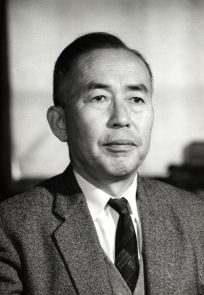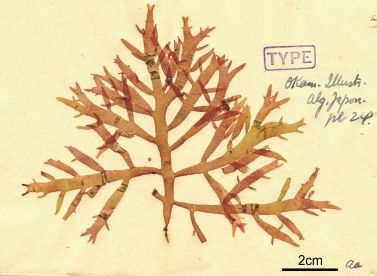
 |
| Dr. Y. Yamada (1900-1975) The 1st Professor of the Phycological Lab., Faculty of Science, Hokkaido Univ. |
SAP was established on 1931, the following year of the establishment of the Faculty of Science, Hokkaido University. The herbarium room (144m2), presently is used for a part of an exhibition room of the Hokkaido University Museum, was on the 1st floor of the building. A few years later the herbarium room was partly reconstructed as a mezzanine structure to store increasing amounts of collections. Though the building of the Faculty of Science was remodeled to the University Museum in 1999, there were no suitable storage facilities for SAP specimens at that time. Only especially important specimens, Type collections and Okamura collections, were kept in the Museum. Many others were temporarily stored in some prefabricated buildings separately. In 2004, all the herbarium specimens deposited in SAPA and SAPS were transferred from the Faculty of Agriculture to the Museum. The marine algal specimens in SAPA, including the type specimens of K. Miyabe's Laminaria species, were combined with SAP specimens and stored in two rooms on the 3rd floor of the Museum (116m2). Thus most of algal specimens in SAP and SAPA, except for liquid preserved ones, have been stored in the Museum. This herbarium is now under joint management of the Faculty of Science and the University Museum.
This herbarium mainly houses marine benthic algal specimens studied by the researchers concerning the Phycological Lab. of the Faculty of Science. It consists of over 120,000 dried specimens and near 20,000 liquid preserved ones not only collected from Japanese waters but worldwide origin, especially from the north-western Pacific (e.g. Aleutian Islands, Kamchatka Peninsula, Kuril Islands, Sakhalin Island, Korean Peninsula, Taiwan Island, Vietnam, Malaysia, Philippines and Micronesia). It is registered officially as the herbarium abbreviation SAP with Index Herbariorum internationally.
SAP houses almost all marine benthic algal type specimens described by Japanese researchers. It is one of the largest marine benthic algal herbarium in the world.
 |
| Champia bifida Okam., holotype specimen. |
Specimen databases of the Hokkaido University Museum
Phycological Lab., Graduate School of Science, Hokkaido Univ.